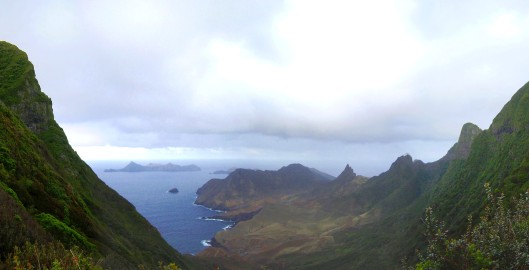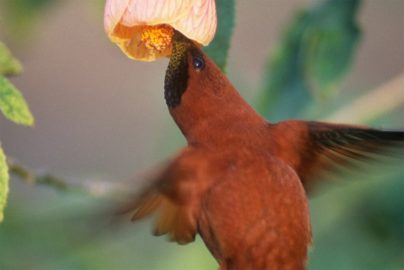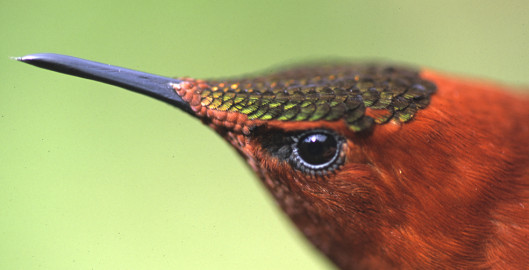Overview
The Juan Fernández Firecrown (Sephanoides fernandensis) is a critically endangered hummingbird found only on Robinson Crusoe Island of the Juan Fernández Archipelago, Chile. Investigation of the factors associated with the decline of this hummingbird revealed that nesting Juan Fernández Firecrowns prefer native forest without invasive plant cover. In response, a forest habitat restoration program was undertaken which includes (1) investigation of effective methods of control of invasive plants, (2) investigation of effective outplanting techniques for native plants, (3) assessment of the response of firecrowns to habitat restoration, and (4) efforts to increase active participation by local residents in restoration.
Quick Facts
Project Location:
Juan Fernández, Chile, -33.6414001, -78.84609929999999
Geographic Region:
Latin America
Country or Territory:
Chile
Biome:
Tropical Forest
Ecosystem:
Oceanic
Area being restored:
15 Hectares
Project Lead:
Oikonos
Organization Type:
NGO / Nonprofit Organization
Location
Project Stage:
Implementation
Start Date:
2003-09-01
End Date:
2011-12-31
Primary Causes of Degradation
Deforestation, Invasive Species (native or non-native pests, pathogens or plants), Mining & Resource ExtractionDegradation Description
The Juan Fernández Islands, Chile, escaped early human disturbance, although cascading effects of human influence began with the islands’ discovery in 1574. Humans heavily harvested timber resources and marine mammals, and have been responsible for a multitude of deliberate and accidental species’ introductions. The 1574 voyage of Juan Fernández left goats and pigs on the island, and subsequent visitors and colonists introduced cattle, sheep, dogs, cats, coati, rabbits, rats, mice, 260 species of exotic plants, and undocumented fungi and insects. There are no native land mammals in the archipelago, and introduced mammals are dramatically changing native systems. Introduced mammals, such as coati, rodents and cats, have been tied to bird predation. Introduced mammalian herbivores can decimate native plants unaccustomed to grazing pressures, providing opportunities for introduced plants to dominate vegetation cover. Regeneration of native vegetation of Juan Fernández has been slowed by introduced goats, rabbits and rodents, as well as by vigorous establishment by introduced plants such as maqui (Aristotelia chilensis, Eleocarpaceae), murtilla (Ugni molinae, Myrtaceae) and zarzamora (Rubus ulmifolius, Rosaceae). The small fraction of the island ecosystem that remains undegraded is restricted to the upper reaches of the island; at lower elevations direct human impact is more common, with associated increases in introduced plants, soil erosion and disturbance. The loss of native forest continues as introduced species continue to invade unchecked.
Native bird species adapted to the native forest communities have shown declines in populations. However, little work has been done to quantitatively assess breeding biology, predation pressures, habitat demands or population levels through time (however, see Hahn 2002). The endemic Juan Fernández Firecrown (Sephanoides fernandensis) is listed as critically endangered in the IUCN red list owing to its low population numbers and a distribution restricted to only one island in the world, Robinson Crusoe. Recent population estimates suggest around 1,000 individuals, which may represent a 10 fold reduction from the early 1900s when it was common in the forests. As this hummingbird population declined, that of the Green-backed Firecrown (Sephanoides sephaniodes), self-introduced in the 1830s, has increased to en estimated 3,000. Population declines of the Juan Fernández firecrown appear to be related to habitat loss exacerbated by predation pressure by cats, increases in exotic plants that decrease available nest habitat and food resources, and competition with the Green-backed Firecrown.
There is only one permanent human settlement on the island, the town of San Juan Bautista, where approximately 600 people reside. Historic resource extraction has been limited, and alternative timber sources are provided by introduced species plantations near town. However, species introductions continue with the arrival of goods and materials from continental Chile. Although residents’ environmental awareness has increased dramatically in the last 15 years, few active environmental protection programs exist for terrestrial or marine ecosystem conservation.
Reference Ecosystem Description
The forests of Robinson Crusoe Island are composed of a suite of endemic trees. Luma (Myrceugenia fernandeziana) dominates forests, and the distribution of a variety of ferns (tree, climbing, arboreal) and a diversity of plants, including endemic trees naranjillo (Fagara mayu), juan bueno (Rhaphithamnus venustus), canelo (Drimys confertifolia) and manzano (Boermia excelsa), depends upon elevation, slope and aspect. The island has a steep mountainous spine that runs its length, rendering some areas inaccessible and also creating a variety of microclimatic conditions. The Juan Fernández Firecrown was abundant across the island, with nests commonly encountered.
Project Goals
These investigations will broaden scientific understanding of this unique ecosystem as well as to inform management actions to restore populations of this endangered bird species. Our proximate goals are to determine effective control methods of introduced plants and effective outplanting methods for native plants, to measure the response of nesting firecrowns to restored habitat, and to increase active participation in restoration by local residents. Our ultimate goals are to restore native forest assemblages and the Juan Fernández Firecrown population, safeguarding these native species against global extinction. This project arose out of an urging from the national park personnel, interested in advancing firecrown conservation.
Monitoring
The project does not have a monitoring plan.
Stakeholders
The Juan Fernández Firecrown is a flagship species for the Juan Fernández Archipelago and the Juan Fernández National Park. After the local lobster fishery, tourism is the second largest contributor to island incomes. Many tourists are attracted to the islands by the large number of endemic species, including the Juan Fernández Firecrown and the unique assemblages of native forest plant species. The national park has control over the protection of species and ecosystems within its borders, however local islanders are increasingly interested in protecting native species and systems as well.
Description of Project Activities:
The Juan Fernández Firecrown has faced dramatic population declines, presumably linked to habitat loss. As the first quantitative assessment of nesting habitat, during 2003 and 2004, we characterized vegetation cover surrounding nest locations and compared them to non-nest locations within 12 ha of forest. Understory cover by invasive plants was the strongest predictor of nest absence.
Mechanical and chemical invasive plant control was undertaken in sensitive nesting areas. Mechanical control alone was insufficient in preventing aggressive regrowth of invasive plants such as Aristotelia chilensis (maqui), and Rubus ulmifolius (elmleaf blackberry), however chemical application within 4 hours after mechanical treatment was effective. Annual control has continued in this area, and is accompanied by measures of efficacy and regeneration of native and invasive plant species. In addition, in 2006-8, survivorship of nests was assessed, and data await analysis examining the relationship between invasive plant control and nesting success in this sensitive endemic hummingbird. Results will indicate the effectiveness of plant control in hummingbird habitat restoration and indicate future directions for recovery work.
We began an additional investigation April 2008 in a degraded native forest to compare efficacy of outplanting techniques. Two endemic trees which provide nectar food resources for the hummingbird, Sophora fernandeziana (madera dura) and Rhaphitamnus venustus (juan bueno), were outplanted under 3 experimental treatments after reaching 3 years in the greenhouse. We collect growth and survival measurements regularly and results will inform appropriate techniques for outplanting these species. In addition to these anticipated results, this research has also generated much needed discussion and involvement surrounding restoration among various stakeholders, such as the national park, the agriculture department, scientists, conservation non-profit technicians and the community.
All aspects of the investigations described here were executed through close collaborations between the U.S. based scientists and local residents, as park personnel were involved in all planning stages, and local residents were trained as field technicians and participated in, and led, plant control and outplanting. In addition, a network of local volunteers assisted in both plant control and outplanting activities as well.
Ecological Outcomes Achieved
Socio-Economic & Community Outcomes Achieved
Sources and Amounts of Funding
These projects have been executed through support from the American Bird Conservancy, the Hummingbird Society, and the Sierra Club Foundation.




